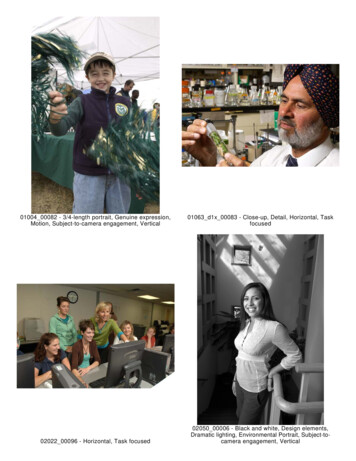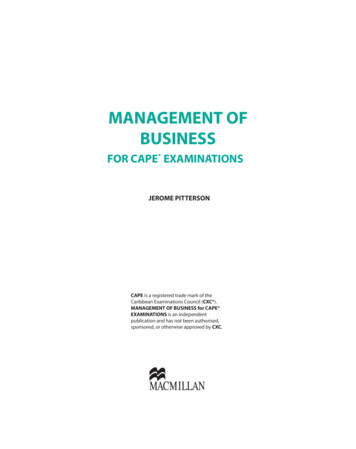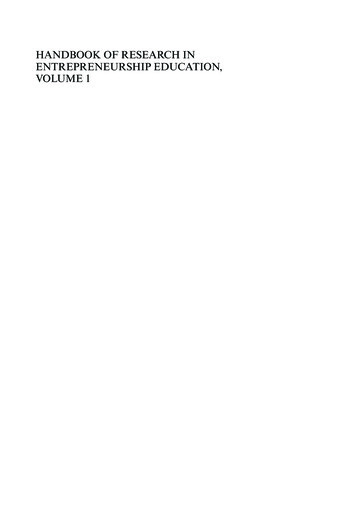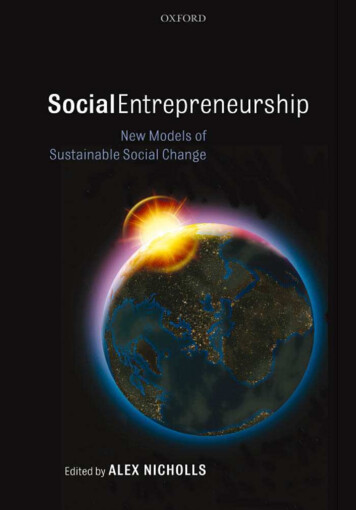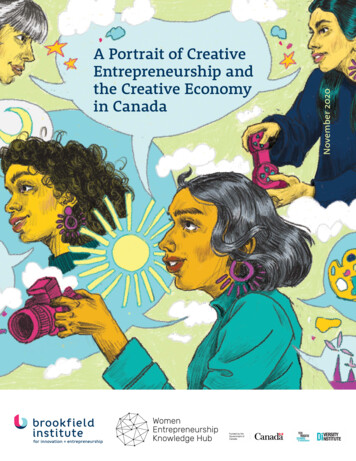
Transcription
November 2020A Portrait of CreativeEntrepreneurship andthe Creative Economyin Canada
Au t hor sSTEPHANIE FIELDINGPolicy Research AnalystNISA MALLIWork Stream ManagerStephanie was a Policy Research Analyst withthe Brookfield Institute forInnovation Entrepreneurship,where she supported projects in theAI Society, Skills for the Innovation Economy,and Entrepreneurship work streams. She recentlyjoined the team at Innovation, Science EconomicDevelopment Canada (ISED) as a member ofthe Digital Design and Digital TransformationService Sector (DTSS). Stephanie’s practice sits atthe intersection of technology, social policy, art,and design. She is interested in how informationinfrastructures and emerging technologies canbe used to engage and benefit the public, thebalance between innovation and ethical practice,and how creative approaches can be incorporatedinto policy. Previously, she co-founded and codirected a contemporary art gallery called 8elevenin Toronto, which received numerous grants andinternational press; and recently participatedin the TRANSITIONS residency at the MilieuxInstitute. Stephanie holds an MI degree in CriticalInformation Policy Studies and User ExperienceDesign from the University of Toronto, a BFAfrom OCAD University in Criticism and CuratorialPractice, and a BA in Art History and Psychologyfrom McGill University.Nisa manages the BrookfieldInstitute’s Innovative Inclusive Economy workstream,studying the intersection oftechnology, labour, economicgrowth, and inequality. She brings a social policyand social services lens to the Institute, havingworked on employment, training, and povertyreduction for federal and municipal governments.Prior to joining the public service, she managed alibrary-based digital literacy and arts program forseniors, newcomers, and jobseekers and workedfor non-profit arts and media organizations. Herart practice is predominantly text-based, includingpoetry, essays, and other forms of storytelling, andhas been supported by the Toronto and OntarioArts Councils and through residencies at the BanffCentre and Artscape Gibraltar Point. Nisa holdsa MA in Public and International Affairs from theUniversity of Ottawa and a BFA in Writing and FilmStudies from the University of Victoria.nisa.malli@ryerson.ca @nisamallisf@stephanie-fielding.com @steph fieldingThe Brookfield Institute for Innovation Entrepreneurship (BII E) is an independent andnonpartisan policy institute, housed withinRyerson University, that is dedicated to buildinga prosperous Canada where everyone has theopportunity to thrive due to an inclusive resilienteconomy. BII E generates far-sighted insights andstimulates new thinking to advance actionableinnovation policy in Canada.For more information, visitbrookfieldinstitute.caISBN: xxx20 Dundas St. W, Suite 921Toronto, ON M5G 2C2/BrookfieldIIE@BrookfieldIIEThe Brookfield Institute forInnovation EntrepreneurshipA Portrait of Creative Entrepreneurship
Con t r i bu tor sJessica Thomson,Marketing and Communications SpecialistPARTNERS FUNDERSHeather Russek,Director of Policy InnovationLianne George,Director of Strategic CommunicationsNeha Ray, IllustratorLindsay Smail, Graphic DesignerAleksandra Szaflarska, Copy EditorMCIS Language Solutions, TranslatorREVIEWERSDr Alia Weston, Associate Professor of Creative andBusiness Enterprise, OCADUAlexandra Hong, Project Officer, OCADU Centre forEmerging Artists and DesignersDr Kim de Laat, Postdoctoral Fellow at the Institutefor Gender and the Economy, University of TorontoThe Women Entrepreneurship Knowledge Hub(WEKH) is a national network and accessible digitalplatform for sharing research, resources, andleading strategies. With ten regional hubs and anetwork of more than 250 organizations, WEKH isdesigned to address the needs of diverse womenentrepreneurs across regions and across sectors. Inresponse to COVID‑19, WEKH adopted an agitatorrole connecting women entrepreneurs and supportorganizations across the country and led networkcalls and training sessions. WEKH’s advancedtechnology platform, powered by Magnet, willenhance the capacity of women entrepreneurs andthe organizations who serve them by linking themto resources and best practices from across thecountry.A Portrait of Creative Entrepreneurship
Ta b l eofCon t en tsLetter from the Authors: Creativeentrepreneurship in the time of physicaldistancing1Current trends and challenges in creative andcultural industries24Introduction: Setting the scene5Case study: Collectives and co-opsCreative work and firms as drivers ofinnovation and value creationCase study: Performing arts52526Support for creative entrepreneurs in Canada 29The scale of creative entrepreneurship:from freelancers to internationallycompetitive firms6Gender and intersectional demographicanalysisCase study: Video gamesWhat’s in a Name? Defining ‘Creative’ and‘Entrepreneurship’Policies, Programs, and Business Supports21Access to funding30Canadian cultural policy307Quebec cultural policy328Recent policy responses and revisions32Conclusion and further research questions35Appendix3710Cultural work/ers and industries11Cultural vs creative11NAICS and NOCS37Definitional approaches11Key policy frameworks38Case study: Fashion13Defining “entrepreneurship”14Gender and intersectional demographicanalysis16Canadian data gaps16Case study: Design17The Economic Impacts of Creative Content,Labour, and EntrepreneurshipEndnotes18Canada18International comparisons19Gender and intersectional demographicanalysis20A Portrait of Creative Entrepreneurship40
L et t erf romAu t hor s:t h eCr e at i v een t r epr en eu r sh i pi nt h et i m ep h y s i ca lofdista nci ngThis literature review explores creativeentrepreneurship in Canada, from freelanceartists to large and internationallycompetitive firms, and provides intersectional andgendered analysis on their work and businesses,and the role of creative entrepreneurship andcreative labour in the innovation economy. It isthe first in a series of reports by the BrookfieldInstitute for Innovation Entrepreneurship (BII E)examining creative entrepreneurship and creativework, building on our previous research on techworkers1 and the tech sector,2 women founders,3and scaling firms,4 and part of our researchinitiative on Women Entrepreneurs in partnershipwith the Women Entrepreneurship KnowledgeHub.5The Brookfield Institute launched this researchproject in Winter 2020, prior to the pandemic.As we write up our report in Spring 2020,the economic, cultural, and social landscapehas changed dramatically, albeit potentiallytemporarily. Creative businesses and organizationshave been hard and directly hit by the 2020pandemic and public health rules forbidding publicgatherings, events, and non-essential in-personwork. Early statistics from the April 2020 LabourForce Survey reported the largest employmentdeclines in industries that involve public-facingactivities where physical contact is required, orlimited ability to work from home. Employmentin the Information, Culture, and Recreation sectordecreased by 23.8 percent between Februaryand April, while overall hours worked fell by 37.5percent including within performing arts andrelated industries, consistent with the cancellationof in-person events, and second only in sectoraldecline to the Accommodation and Food Servicessectors (-23.9 percent /-63.8 percent).6 Many whoare self-employed are experiencing deterioratingbusiness conditions: across all sectors, 59.4percent (1.2 million people) of solo self-employedpeople across all sectors reported working lessthan half their usual hours during the referenceweek, including 38.4 percent who did not work anyhours.7 Creative businesses and organizations withoffices, studios, and storefronts are experiencingthe same well-documented financial challengesas other commercial renters during a period ofreduced or closed operations.8 The impacts ofthe pandemic will likely be felt by the creativecommunity for an extended period of time. AsMusic Canada reports, bookings for 2021 are farlower than usual for many music professionals,with many not expecting a return to the stagesoon due to government restrictions or personalrisk assessment of performing with the virus stillpresent.9 Physical distancing has also had animpact on collaboration and co-creation, withinteractions between artists and creative spaceslimited.10A Portrait of Creative Entrepreneurship1
Within this context, the pandemic has bothexposed and exacerbated existing inequalities.Data on infection rates in the United States (US)by race demonstrates that Black, Latino, andIndigenous people are experiencing higher ratesof infection and death due to a combinationof lower health levels and higher exposure,particularly at work.11 Public Health Ontario hasidentified “existing structural inequities [that] maycontribute to increased risk from COVID-19 in Black,Latino and other ethnic minority and low-incomepopulations [as well as] sex/gender, Indigenousidentity, homelessness, incarceration, and migrantand refugees status.”12 The Canadian Centre forPolicy Alternatives reports that, as of May 2020,two in five youth (aged 15-24) and half of workersmaking 16 per hour or less lost their jobs or themajority of their hours, while many lower wagejobs such as grocery store workers, delivery andtaxi drivers, and long-term care orderlies weredeemed essential and continued to go to work atheightened personal risk.13At the same time, consumption of virtual arts andculture is increasing and dissemination models aredigitizing, including for-fee and free programmingsuch as streaming services for television, movies,and music14 and traditionally live performancesnow available on Instagram, Facebook, Youtube,Zoom, and Twitch.15 Video game hardware,software, and accessory sales for the US for March2020 were the highest they have been since 2008.16Many businesses have pivoted from in-person toonline sales and delivery, or now offer curbsidepick-ups, including bookstores and other retailoutlets.17 Dance studios have shifted online18 alongwith performances, practice spaces, and classesof all genres19 and new digital-first programmingand educational opportunities have launched. Forexample, CBC’s Arts Uncontained is commissioningoriginal programming including digital originals,adaptations of plays that were disrupted bythe pandemic, written and video diaries fromartists, and museum and gallery exhibitiontours. Taking advantage of the virtual mediumto reach beyond local experts and participants,Ryerson’s Communities Create Initiative, supportedby a consortium of Canadian media and artsorganizations, hosts weekly creative workshops ledby Canadian artists and makers from a variety ofdisciplines.There has also been a rise in the use of illustratedinfographics, data visualizations, public art(including both unapproved city-sanctionedinstallations and murals) and other visual andart-based knowledge translation, dissemination,and declarations as a communication tool forpublic health, anti-racism education, and protest.20The Black Lives Matter protests response to thekillings of George Floyd, Breanna Taylor, RegisKorchinski-Paquet, Elijah McClain, and othershave used performance including dance andmusic, photography, craft, and graffiti. Art has longbeen a tool for social change and connection, forcommunicating ideas and voicing dissent, and forparticipatory community engagement21 22 and thisremains true today.New programming, mediums, and disseminationchannels are making arts and culture moreaccessible to those with a fast internet connectionand home devices, but it is not compensating forthe full loss of income to individual artists, artsorganizations, and creative businesses. ArtsPondreported an average income drop of 25,189 and 36gigs lost among 796 Canadian artist respondents23between March 30 and May 27, 2020. As of May2020, the American Association for the Arts (AAA)was reporting a 5.5 billion economic impact forU.S non-profit arts and culture organizationsalone.24 No comparative data is yet available forCanada where restrictions on event size, publicgatherings, and business closures have beenextended.25 Ninety-five percent of the 11,000 artistswho responded to a survey by the AAA reportedthat they had experienced a loss of income fromtheir artistic practice due the pandemic, includingcancellations, project delays, and illness, withan average annual estimated income decline of 27,103. Sixty-eight percent reported that they hadexperienced unanticipated expenditures such asunplanned travel, new cleaning or disinfectingprocedures, and new technology or marketingapproach, and 80 percent said that they do nothave a plan to get back on their feet, with morethan half reporting that they had no savings.Sixty-six percent said they could not access theA Portrait of Creative Entrepreneurship2
resources they needed to continue their creativepractice, including supplies, physical space, andsocial networks. Forty-nine percent of those whoalso worked in non-creative jobs said that theyhad been laid off or furloughed,26 which maysuggest higher numbers of hybrid employmentin more precarious or predominantly in-personoccupations.27 In many countries, artists have thehighest rates of holding second jobs, comparedto other occupations, including high rates ofcombining employment and self-employment andusing multiple job-holding as a transition stage toentrepreneurship, making them potentially moreprecarious in a recession.28A survey by the Canadian Council for the Arts(CAC) reported that 61 percent of self-employedartists and smaller arts organizations and groupswould need to rely on emergency income supportmeasures in order to mitigate the financialimpact of the pandemic, including the CanadaEmergency Response Benefit (CERB), CanadaEmergency Business Account (CEBA), and CanadianEmergency Wage Subsidy (CEWS).a, 29 However,access to these funds has remained elusive formany in the creative sector, with some applicantsreporting that they are ineligible due to not earningenough income in 2019, earning too much selfemployment income,30 receiving royalties for pastwork, or having inconsistent income—all commonrealities in gig-based creative labour and microenterprises.31 Many smaller arts organizationshave also been affected, particularly those undera certain size, with budgets below 500,000, andthose whose workers are considered to be selfemployed and thus deemed ineligible for payrollrequirements for government wage subsidiesthrough CEWS.32 Such eligibility constraintshave prompted some self-employed artists andcultural workers to reconsider gig or employmentopportunities which would help keep them afloatduring uncertain times.33 In response, in April 2020the federal government expanded the reach ofCERB to include support for those still working butmaking less than 1,000 a month and extendingthe program to unemployed seasonal workers whohad exhausted their regular Employment Insurance(EI) benefits34.Many in the creative and cultural industries havestressed the need for additional governmentassistance to address the challenges now facingtheir sector in the long term.35 This advocacyincludes, for example, an open letterb, 36 to theCanadian government, written in July 2020 by agroup of independent artists, writers, technicians,and performers, alongside 34 arts organizations,guilds, and unionsc, 37 asking for the “guarantee[of] basic income for those in need, regardless oftheir work status.”38 As the group suggests, sucha guarantee could be built on existing programs,such as CERB, which many artists already rely onfor income while public gatherings and indoorvenues are banned. Though self-employed peoplehave been able to pay into and access EI as of 2010,uptake was historically low until CERB. As of May2020, 40 percent of self-employed people reportedapplying to CERB, compared to 12 percent of privatesector workers and five percent of public sectorworkers. An August 2020 announcement fromthe federal government confirmed that a parallelincome support program, for those who do notqualify for EI, is forthcoming.39The Canadian government has announced 500million in pandemic-related funding for arts,sports, and culture sectors, and the workers theyemploy This includes funding aimed at “televisionproduction houses, publishers, community andlocal papers, music associations, and mediaorganizations”, nonprofits that are “too small toqualify for bank credit or additional loans,” andb In the form of an open letter written by Zainub Verjee,Clayton Windatt, and Craig Berggold addressed to the PrimeMinister Justin Trudeau, then-Deputy Minister ChrystiaFreeland, then-Finance Minister Bill Morneau, and the Ministerof Canadian Heritage Steven Guilbeault.c Including the Writers’ Union of Canada, Playwrights Guildof Canada, the International Alliance of Theatrical Stagea The CAC survey did not account for those applicants whoEmployees, the Canadian Federation of Musicians, and thewere eligible and reliant on Employment Insurance (EI) duringCanadian Actors’ Equity Association, CARFAC Ontario, CARFACthe pandemic.Alberta, and others.A Portrait of Creative Entrepreneurship3
organizations such as FACTOR d and Musication thatsupport Canadian music talent. Some provincialgovernments have committed additional funding,including 250 million from the Government ofQuebec to encourage creative professionals andartists to start producing again, announced justbefore recording studios and filming for TV andmovies were allowed to reopen in the province.40Most major arts funders, including the CanadaCouncil for the Arts (CAC), have decided not toclaw back funding already spent on events orprojects that were postponed or cancelled andare offering advances on funding for core-fundedorganizations41 Several, including the Toronto ArtsCouncil, have launched emergency funds.42 Theoverall situation is one of challenging unknowns,precarity, and innovative resilience amongCanadian artists and creative entrepreneurs.Our aim with this paper is to paint a picture ofcreative entrepreneurship in Canada prior to2020, identify areas for further research, and tohelp imagine a future for the arts and creativebusinesses. As of now, it is not yet certainwhat the medium or long-term impacts of thepandemic, physical distancing, and businessclosures will be on creative entrepreneurs,businesses, organizations, and workers. But it isclear that the sector remains culturally, socially,and economically vital, and that there is a needto understand the contributions and operationsof creative labour and entrepreneurship and tocreatively imagine a safe future for performance,collaboration, and convenings.d The Foundation Assisting Canadian Talent on Recording(FACTOR).A Portrait of Creative Entrepreneurship4
I n t roduct ion:Set t i ngt h escen eC R E AT I V E W O R K A N D F I R M S A SD R I V E R S O F I N N O VAT I O N A N D VA LU EC R E AT I O NCreative work, defined as “the work involved inthe production of symbolic, artistic and innovativeproducts within [ ] creative industries,”43 and thecreative economy more broadly, is a significantsector in Canada and abroad and a majorcontributor to national gross domestic product andeconomic development.44 It can spur innovationand knowledge transfer across all sectors of theeconomy, creating both commercial and culturalvalue and generating revenue through tradeand intellectual property rights.45 It can createexperiences, contribute to vibrant nightlife ordaytime culture, and provide entertainment,beauty, discomfort, and awe. At the individuallevel, arts and culture can encourage reflectiveness,empathy, understanding, health and well-being,civic engagement, and support education andlearning.46 As OCAD researchers Alia Weston,Sara Diamond, Rachna Kuamr, Royen Dion-Van,and Markus Gordon describe: cultural contexts,content, and activities can create a sense ofidentity, engagement, and relationships withinand between communities, resulting in rich civicbenefits and human bonds.47The United Nations Educational, Scientific andCultural Organisation (UNESCO) Convention onthe Protection and Promotion of the Diversityof Cultural Expressions notes that the culturaland creative industries are essential for inclusiveeconomic growth, reducing inequalities, andachieving the 2030 Sustainable Development Goals(SDGs).48 The 2018 United Nations Conferenceon Trade and Development (UNCTAD) CreativeEconomy Outlook recognized that the sector iscritical for fostering inclusive development andas an input into other small and medium-sizedenterprises.49Artists and creative workers and businesses area significant driver of innovation in products,processes, services, and distribution,50 both insideand outside creative firms and industries.51 AsGreg Hearn, Ruth Bridgstock, Ben Goldsmith,and Jess Rodgers describe in the introductionto their book Creative Work Beyond the CreativeIndustries: Innovation, Employment and Education,the dynamics of innovation in contemporaryeconomies cannot be understood as derivingonly from science and technology, but rathermust include an understanding of the role playedby those creative occupations that are engagedindustrially.52 Creative Canada, the federalA Portrait of Creative Entrepreneurship5
government’s most recent major policy frameworkfor the sector, notes that “the economies of thefuture will rely on creativity and innovation tocreate jobs and foster growth,” and identifiescreative content and industries as “an engine ofeconomic growth and a competitive advantage.”53A 2008 study by Nesta on Hidden Innovationin the Creative Sector noted that much of thisinnovation is not visible or captured usingtraditional indicators including research anddevelopment (R D) surveys and tax credit systems.This includes the development of new products,organizational forms, and business models;novel combinations of existing technologies andprocesses (e.g., repackaging and reselling mediain different formats); on-the-job innovations(e.g., particular lines of code in video games); andtaking advantage of new technological platformsfor digitization and distribution for an increasinglysophisticated consumer and firm audience andclientele.54 The United Kingdom’s (UK) Artsand Humanities Research Council project onUnderstanding the Value of Arts and Culture notedthat some of the most important contributions ofarts and culture lie in the individual experience:“perhaps not economic impact but rather thecapacity to be economically innovative andcreative; perhaps not urban regeneration drivenby large new cultural buildings but rather the waysmall-scale arts assets and activities might helpcommunities and neighbourhoods.”55Digital endeavors are particularly important inboth city-building and community projects, withsuccessful cultural spaces and projects bridgingthe digital and physical, as well as promoting civicengagement.56 While not all creative businessesbelong within the “digital economy” or the “techsector,”57 some definitions include video game andsoftware companies, digital design, virtual andaugmented reality, and other fields that straddlethe creative and the digital. Creative workersand firms are embedded in a range of industriesincluding manufacturing, banking, and mining, aswell as supply services to other businesses and thegeneral public, such as architects, technical writers,UX designers, and illustrators.58T H E S C A L E O F C R E AT I V EENTREPRENEURSHIP: FROMF R E E L A N C E R S T O I N T E R N AT I O N A L LYCOMPETITIVE FIRMSCreative entrepreneurship can take form in a rangeof firm scales and sizes, from zero-profit individualcreative arts and craft practices to successful fulltime freelancers to large firms, including Canadianbranches of international firms and internationallycompetitive homegrown firms. However, a goodportion of this creative work happens outsideof formal employment relationships in forms ofsolo-entrepreneurship and project-based freelancework; what many researchers have described as“portfolio careers.”59 These patchwork contractbased employment situations reflect a need forindividuals to be “entrepreneurial” in pursuitof their career and professional opportunities.According to Statistics Canada, workers whosemain occupations were in Arts, Entertainment andRecreation were four times more likely to be gigworkers than workers whose main occupationswere in company or enterprise management.60As Alex Wong from OCAD University’s Centre forEmerging Artists and Designers (CEAD) describes,the type of support needed by a freelancer orentrepreneur is very different from a scalablecompany, which should be considered in any policyframework or funding model concerned with thissector.61“Relative to other professional occupations,artists freelance at a much higher rate andhave a greater share of workers switchinginto (and thus also out of) freelance in anygiven year. In short, artists disproportionatelyfreelance and have a disproportionatechurn through freelance status (which) maybe related to labor market contractions.”—Joanna Woronkowicz and DouglasS. Noonan, Who Goes Freelance: TheDeterminants of Self-Employment62A Portrait of Creative Entrepreneurship6
Defining gig workersStatistics Canada defines gig workers asworkers who “enter into various contractswith firms or individuals to complete a specifictask or work for a period of time for whichthey are paid a negotiated sum.” This includes“unincorporated self-employed freelancers,day labourers, or on-demand or platformworkers.”63“Most creative workers [.] are contractlabourers rather than permanentemployees, are highly mobile in their placeof employment, will typically experience‘portfolio careers’ or multiple careerpathways, and are less likely than in the pastto be employed and trained through large,often public sector, agencies.” —Greg Hearnet al., Creative Work Beyond the CreativeIndustries: Innovation, Employment, andEducation64GENDER AND INTERSECTIONALD E M O G R A P H I C A N A LY S I SMany of these creative workers and entrepreneursare women, non-binary people, and those of othermarginalized genders who are not well capturedin older national surveys. Looking specifically atartists,a Hill Strategies found that 52 percent wereself-employed as of 2016 compared to 12 percentof all Canadian workers, and that the number ofartists in Canada whose main occupation is theirart (158,100) is greater than the labour force ineither Automotive Manufacturing (146,200) or thea Artists are defined in this study using the occupation codesfor: musicians and singers; authors and writers; producers,directors, and choreographers; visual artists; artisansUtilities (136,400) sectors.65 As of 2014, womenowned businesses comprised 25.5 percent of allincorporated businesses in the Arts, Entertainment,and Recreation sector in Canada, and 20.9 percentof incorporated businesses in the Informationand Cultural Industries. Also noteworthy is theindustry-level high of 35 percent women-ownedbusinesses in Educational Services and the industrylow of seven percent in the Construction sector.Women comprise 44.4 percent of self-employedworkers in the Information, Culture, and Recreationsector, up from 35.2 percent in 1987 and reflectingan upward trend across all sectors other thanEducational Services, in which women’s sharehas decreased slightly over the same period.66 Asof 2016, women whose main occupations werein Arts, Entertainment, and Recreation had thesecond highest rates of “gig work” across sectors(17.7 percent proceeded only by Other Services(except Public Administration) at 20.1 percent andhad higher rates than their male counterparts (15.6percent). Women and men in Information andCultural Industries had approximately the samerates of gig work: 10.2 percent and 10.3 percent,respectively.According to the 2016 census, 5,000 artistsidentified as Indigenous (3.1 percent of totalartists), and 23,300 identified as racialized artists(15 percent of total artists) in Canada. Incomebetween racialized and non-racialized groups stillvaries widely—in 2016 Indigenous women artistshad a median income of 17,800, racialized womenartists earned 17,900, and immigrants earned 20,800. This stands in comparison to an incomeof 24,300 for non-Indigenous, non-racialized,and non-immigrant Canadian artists.67 In otherwords, for every dollar made by non-indigenous,non-racialized, and non-immigrant Canadianartists, racialized artists make 0.72, Indigenousartists earn 0.68, Francophone artists earn 1.15, and Anglophones in Quebec make 0.85.Overall, women artists in Canada make 0.82 oftotal income for every 1 earned by their malecounterparts.68and craftspeople; actors and comedians; dancers; otherperformers; and conductors, composers, and arrangers (listedhere in order of the number of workers in the occupation fromlargest to smallest).A Portrait of Creative Entrepreneurship7
The Brookfield Institute recognizes that: People with different gender identitiesand expressions, including non-binarygenders and trans people, experiencedifferent barriers, inequities, andunderrepresentation in entrepreneurshipand work, including in the creative sectorand occupations. When reporting onstatistics gathered from external sources,including Statistics Canada, our workreflects the terms used in and the datacollected by the surveys and this can createlimitations in our analysis. Our qualitativeresearch on entrepreneurship, includinginterviews, focus groups, and surveys seeksto intentionally consider and account forthese limitations. As a lawyer and professor, Kimberlé Crenshawhas defined it: “Intersectionality is a lensthrough which you can see where powercomes and collides, where it unlocks andintersects.”69 Wherever possible, this literaturereview has sought to analyse and reportinformation on characteristics other thangender—including ethnicity, immigrationstatus, and income, and how p
A PortrAit of CreAtive entrePreneurshiP tAble of Contents Letter from the Authors: Creative entrepreneurship in the time of physical distancing 1 Introduction: Setting the scene 5 Creative work and firms as drivers of innovation and value creation 5 The scale of creative entrepreneurship: from freelancers to internationally- competitive firms 6
